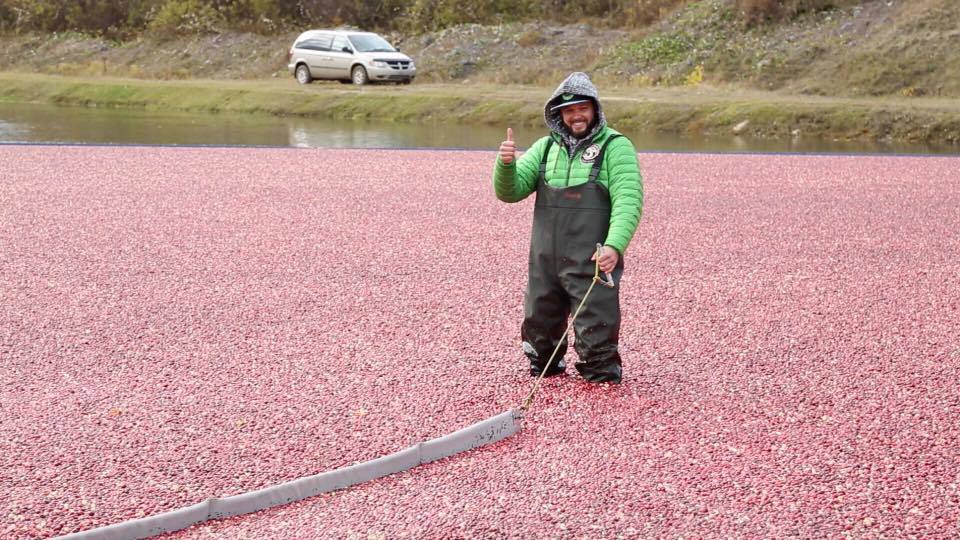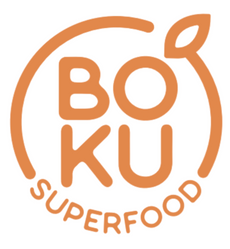
The CEO of BoKU Superfood, Lynn Rolle and her son, Reno Jr just took an amazing trip to Quebec, Canada to visit the cranberry bogs that our Bliss Berries are grown at! They had such a great time and we wanted to share this Q&A with Reno Jr. so you can experience it as well. Enjoy!
Q: Is the cranberry bog you visited where Boku’s Bliss Berries are sourced?
A (Reno Jr): Yes, the cranberry farm we visited is one of the small family owned facilities where the cranberries that we use are sourced. In Quebec, Canada our cranberry partner has agreements with hundreds of local cranberry farmers that they source from. They believe that the local people who have been growing cranberries for hundreds of years are the best farmers to grow their amazing cranberry crop.
Q: Why did BoKU choose this cranberry source for Bliss Berries?
A (Reno Jr): Different large companies (we will keep the names secret!), who uses giant industrial growing operations, our vendor chooses to work hand in hand with many different local organic growers to help support the community and ensure that they can grow and harvest in the most sustainable and environmentally friendly way possible. The farm we visited was so picturesque and situated next to a river in fields surrounded by small villages. We may have been in Canada, but it looked like we were in J.R.R. Tolkien’s Shire!
Q: What was Quebec City like?
A (Reno Jr): Wow, where to begin? It would be a shame not to mention that Quebec City, our basecamp, was easily the most beautiful North American City I have ever been to. Small and crooked cobblestone streets, stone bastions, ancient 16th-century city walls. It is situated on a clifftop overlooking the St. Lawrence river and complete with its own picture perfect European castle. Yes, this place is magical. So needless to say, if the authenticity and charm of the city extended into surrounding areas, it was going to be an amazing experience.
Q: What were your expectations going into this experience?
A (Reno Jr): Going into it, I didn’t have any preconceived notions, except for funny commercials I would see growing up from a very large corporation. However, those commercials were in the U.S. and we were in French Quebec, where everything seemed different. So, heading in I was open minded and really did not know what to expect. The one thing that I was certain of is that I was going to be cold. in Quebec City, the morning we left to travel to the bog, it was 29 degrees and snowing. We were escorted to the headquarters of our vendor by none other than Captain Cran Man haha, AKA Steven Lakowski who was easily the most entertaining guy we met from our vendor.
Q: What stood out most to you at the bog?
A (Reno Jr): When we got there we were introduced to Mario, a cranberry production expert. He kindly took us in another car to a family farm about 15 minutes away to experience the bog. When we got there Mario explained that the location of this particular bog and the ones around it were very pristine because of the water source that they use. The river that ran through the area was fed by a pure spring water aquifer and it was of very high quality. The system of bogs that the farm was using was incredible. They were roughly 200 yards long and 75 yards across in the shape of a big football field. Each bog was connected by gravity fed water systems that irrigated all of them effortlessly. The most amazing thing about this bog was that it was surrounded in the distance by a small village and was pristine and clean. Not to mention that it was sprinkling snow with intermittent sunshine.
Q: That sounds amazing! What is the actual process in harvesting like?
A (Reno Jr): In a nut shell, the cranberries start out as 8-15 inches high , tiny little shrubs that grow very low to the ground. Each little shrub produces around 15 berries which are about as big as a table grape, but more dense and red. Mario explained that the very cold climate in Canada is not hospitable for most pests and insects that might otherwise damage a crop, if it is grown in a warmer location like in the U.S. Therefore, they typically product around 25-45 tons an acre which is much more than the U.S. and other areas. When the cranberries are ripe around mid-October) a tractor with a thick brush comes and gently brushes the shrubs and loosens the berries which fall on the ground. instead of handpicking the berries off the ground, Mario explained that the farmers open the flood channels connected to the river and flood one bog at a time, using the same recycled ice cold water from bog to bog to conserve water.
Q: That’s great they are sustainable and use recycled water. Did they put you to work while you were there?
A (Reno Jr): Oh yes! Just as I was beginning to wrap my mind around this process, I was being squeezed into water proof waders and ushered off around a corner into another bog. OMG…this bog unlike the rest of them had not been processed yet and the sun shone brightly on the many thousands, if not millions of sparkling red berries. I told Mario that I wanted to join the crew for this harvest and he laughed and said he would ask. Surprisingly, the burly looking workers waved me into the bog speaking only in French and smiling as if anticipating my failure. I had no time to see how it was done as I was handed one end of a giant plastic line that stretched across the bog my partner, holding their other end, waved at me to drop the thick plastic barrier in the water and walk towards him. I obliged. Eager to show my new colleagues that I was up for the challenge, I drug the line through the water and started to drag an insane amount of cranberries towards the giant suction hose that would suck the berries up into a truck for processing.
Q: How exciting! Was it difficult?
A (Reno Jr): The first run was a little tricky especially at the end when we had to finesse around the drain and alternate directions in order to get every last berry into the mouth of the hungry suction hose. I quickly became proficient at their technique which at first looked confusing and almost impossible. I was the only one not wearing thermal gloves and the more runs I made around the bog, the more my new friends seemed to cheer up and laugh, giving me thumbs up and encouragement. I felt like one of the boys and stayed in the bog until I was forced out by Mario because we had to make our way back to the factory. My work mates didn’t want me to leave, yelling at Mario in French apparently telling him that I was a good worker and that they couldn’t finish without me lol.
Q: Sounds like a wonderful experience, what was your favorite part?
A (Reno Jr): My favorite part of the bog, hands down was working with the farmers and experiencing the collection process. Nothing like picking a handful of cranberries right out of the bog and shoveling them into your mouth for some energy mid harvest!
Q: Why is it important to you to get to know the farmer’s you source raw ingredients from?
A (Reno Jr): I think that people are with me these days when I say that it is so important to know where your food comes from. The clear majority of the food we eat in this country comes from a farming conglomerate or some mass production line and is heavily processed and sold to the masses. Many of the foods that are grown are also subjected to genetic modification in order to survive the mass amounts.of herbicide and pesticide that are required to grow on that type of scale. We at Boku feel that it is of the utmost importance to meet these farmers and see how they grow their crops. What kind of attention to detail do they have? What kind of care and effort do they put into their crops? These are all important aspects of us personally choosing our vendors.
The way we do things at Boku is a bit old fashioned in that we work hard to ensure that we have the highest quality ingredients in the world. Period. We are not worried about cutting cost in lieu of getting the best. The people that we do business with must have the same goal or we simply do not do business with them. I learned from my father that facts tell and stories sell. Anyone can make superfood powders from vendors they don’t know and don’t have a connection with. At Boku we want to create a story that starts from a seed and ends at your table. We want to be able to tell you with personal experience how the food is grown, dried, and powdered. We want to know the names of the farmers and see the landscape, so we can paint a picture for our consumer that is based on actual experience. It is these experiences at all of the different farms that we visit that helps us tell our story and why we are the best.
